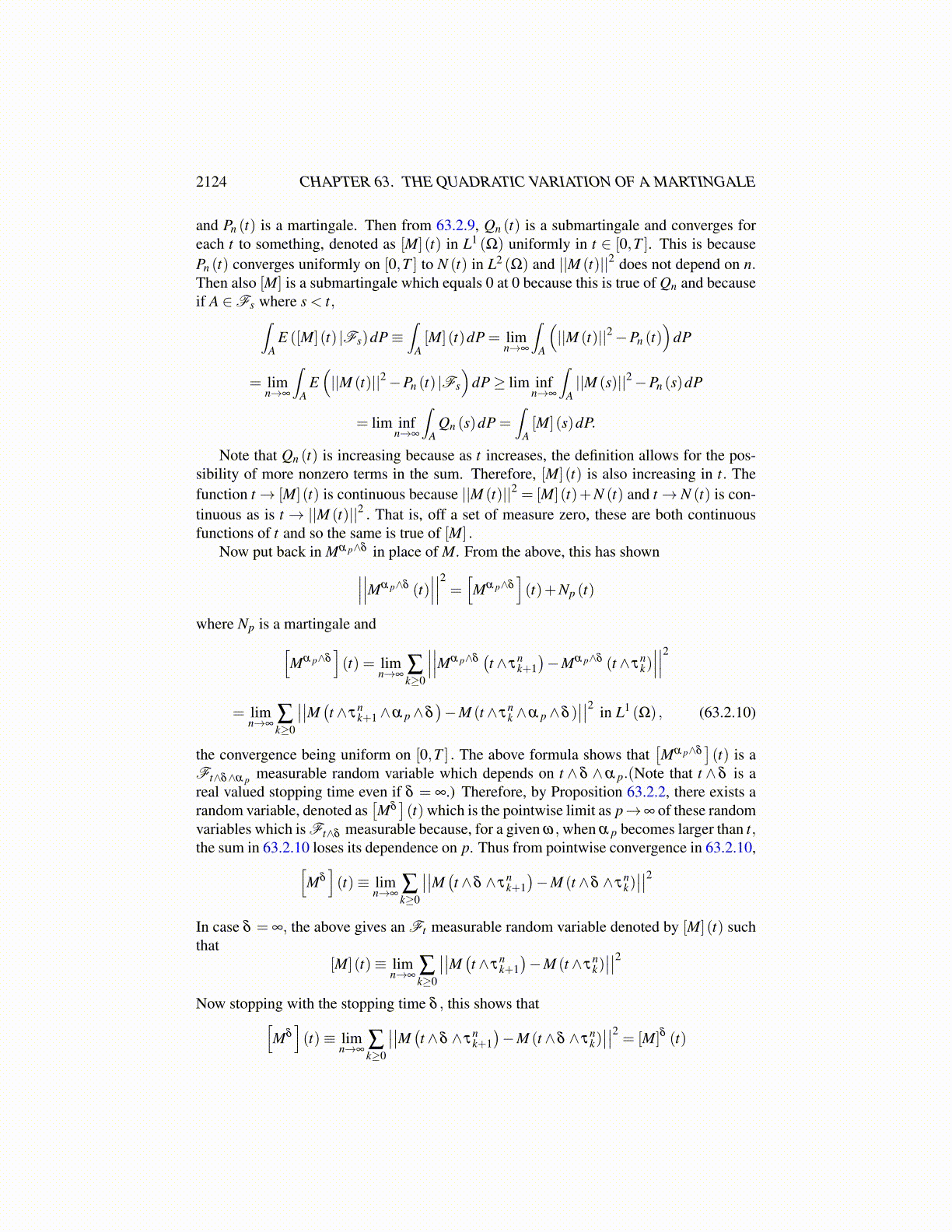
2124 CHAPTER 63. THE QUADRATIC VARIATION OF A MARTINGALE
Using a similar manipulation to what was just done to show the mixed terms equal 0, thisequals
C2q
∑k=p
E(∣∣∣∣M (t ∧ τ
nk+1)∣∣∣∣2)−E
(||M (t ∧ τ
nk)||
2)
≤ C2E(∣∣∣∣M (t ∧ τ
nq+1)∣∣∣∣2− ∣∣∣∣M (t ∧ τ
np)∣∣∣∣2)
The integrand converges to 0 as p,q→ ∞ and the uniform bound on M allows a use of thedominated convergence theorem. Thus the partial sums of the series of 63.2.6 converge inL2 (Ω) as claimed.
By adding in the values of{
τn+1k
}Pn (t) can be written in the form
2 ∑k≥0
(M(τ
n+1′k
),(M(t ∧ τ
n+1k+1
)−M
(t ∧ τ
n+1k
)))where τ
n+1′k has some repeats. From the construction,∣∣∣∣M (τn+1′
k
)−M
(τ
n+1k
)∣∣∣∣≤ 2−(n+1)
Thus
Pn (t)−Pn+1 (t) = 2 ∑k≥0
(M(τ
n+1′k
)−M
(τ
n+1k
),(M(t ∧ τ
n+1k+1
)−M
(t ∧ τ
n+1k
)))and so from Proposition 63.1.4 applied to ξ k ≡M
(τ
n+1′k
)−M
(τ
n+1k
),
E(||Pn (t)−Pn+1 (t)||2
)≤(
2−2nE(||M (t)||2
)). (63.2.8)
Now t→ Pn (t) is continuous because it is a finite sum of continuous functions. It is alsothe case that {Pn (t)} is a martingale. To see this use Lemma 63.1.1. Let σ be a stoppingtime having two values. Then using Corollary 63.1.3 and the Doob optional samplingtheorem, Theorem 62.7.14
E
(q
∑k=0
(M (τn
k) ,(M(σ ∧ τ
nk+1)−M (σ ∧ τ
nk))))
=q
∑k=0
E((
M (τnk) ,(M(σ ∧ τ
nk+1)−M (σ ∧ τ
nk))))
=q
∑k=0
E((
E(M (τn
k) ,(M(σ ∧ τ
nk+1)−M (σ ∧ τ
nk)))|Fτn
k
))=
q
∑k=0
E((
M (τnk) ,E
(M(σ ∧ τ
nk+1)−M (σ ∧ τ
nk))|Fτn
k
))=
q
∑k=0
E((
M (τnk) ,E
(M(σ ∧ τ
nk+1∧ τ
nk)−M (σ ∧ τ
nk))))
= 0